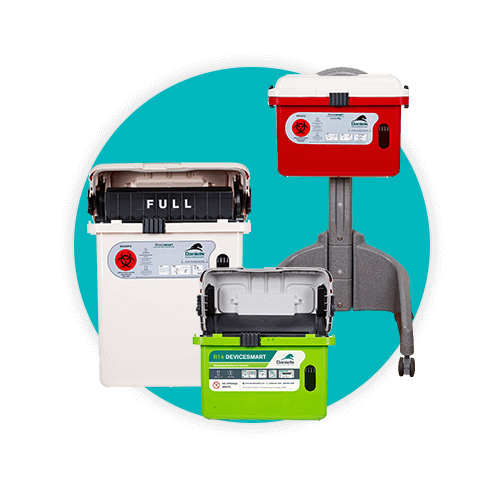Medical Waste Considerations for Dentists

As an independent dental practitioner, a member of a dental group, or an oral surgeon, are you well-informed when it comes to medical waste considerations? Did you know that a dental practice produces some similar types of medical waste as a doctor’s office or surgical center?

Daniels Health focuses on compliance to ensure that medical waste generated by any dental facility is properly handled, stored, treated, transported, or disposed of. Some of the most common types of medical waste stream categories produced by a dental office includes:
- Sharps
- Hazardous waste
- Regulated medical waste
Generally speaking, dental hazardous waste management concerns can include but are not limited to:
- Amalgam
- Disinfectants
- Old crowns
- Lead foil
- Chemicals used in x-ray processing
There’s no excuse for not knowing the rules
Dental practices should be aware of federal and state regulatory guidelines when it comes to dental office waste. Terminology is important, as some of the waste generated by a dental facility can be defined as hazardous waste or universal waste, depending on state. When in doubt, adhere to federal guidelines. Regulatory guidelines in regard to common hazardous dental office wastes are under the purview of the Resource Conservation and Recovery Act (RCRA).
If you’re not properly segregating and managing your medical waste generated by your dental facility, you’re increasing your risk of noncompliance and resulting fines and penalties. Greater focus in recent years has been placed on disposal of dental amalgams.
In 2017, the American Dental Association released new guidelines regarding management of amalgam waste, requiring “most dental practices nationwide to install devices, called separators, to capture dental amalgam waste, preventing its release to sewer systems.” The phase in for this new federal regulation extends through mid-summer 2020, but as of July 2017, “new dental offices which discharge dental amalgam must comply immediately with the standards of this rule.”
Daniels Health is dedicated to providing authoritative, safe, and cost-effective and clinically designed solutions for dental practice medical waste.
To avoid possible fines and penalties due to noncompliant disposal of medical waste, it’s essential that every employee of a dental practice be aware of governmental regulations regarding heavy metals commonly found in the dental industry. Silver and mercury are still used today. These guidelines are also applicable to teeth being removed that contain any metal, as well as dental procedures that employ metals or other amalgams, which typically contain metal alloy mixtures and liquid mercury.
What about damaged dentures? Do you know how they’re classified? In most states, teeth and some types of dentures are classified as pathological waste. Do you know how teeth are to be disposed of? Do your employees? Unless they contain amalgam, teeth are required to be placed in red bags or can be put in a sharps container. The CDC states that discarded extracted teeth are “potentially hazardous” and fall under the guidelines of the Occupational Safety and Health Administration’s Blood-borne Pathogen Standard. However, this guideline doesn’t apply to all states. For example, extracted teeth in North Dakota are classified as regulated medical waste, but in Pennsylvania, they’re not.
We know the rules – do you?
Different rules apply depending on whether or not the teeth contain amalgam fillings. Does your office staff know how to properly segregate dental medical waste? Amalgam can’t be incinerated because portions of the fillings typically contain mercury. Incineration of mercury means pollutants are generated into the air, posing a potential health risk. Therefore, removal of amalgam before disposal is highly recommended. The Environmental Protection Agency (EPA) provides detailed information for dental office medical waste under 40 CFR part 441. Daniels Health knows that wading through dozens of sections of federal and state guidelines and regulations can be daunting, but we’ll help you get through it.
Title 40: Protection of the Environment, and Title 40, Chapter 1, Subchapter N, Part 441 specifies federal regulations designated as the Dental Office Point Source Category. The contents of this section focus on definitions, some dental dischargers, amalgam separators, and recommendations for compliance. For example:
- Section 441.10 Applicability.
- Section 441.20 General definitions.
- Section 441.30 Pretreatment standards for existing sources (PSES).
- Section 441.40 Pretreatment standards for new sources (PSNS).
- Section 441.50 Reporting and recordkeeping requirements.
Ensuring that your practice is EPA compliant is essential to avoiding massive fines. However, state and local regulations also apply, which are often even more stringent than federal guidelines. Know the facts supplied by the EPA as well as regulations found under EPA’s Resource Conservation and Recovery Act in regard to proper management, handling, and disposal of dental office waste.
Make sure that employees of your facility are able to identify all hazardous waste materials generated by your dental practice. Don’t store large amounts of hazardous waste on site, and ensure that hazardous waste is transported according to regulations to off-site treatment, recovery, or disposal facilities.
Daniels Health recommends that dental practices take a cradle-to-grave approach to medical waste management that aids in the adequate, compliant, and safe handling of dental waste from generation through disposal. For more information on how Daniels Health can help your dental facility stay on top of ever-changing guidelines, call us today.
Let's Talk!
Your time is valuable, and we don’t want to play hard to get. You can either phone us directly on the details listed on our contact page, or feel free to fill out this short form and one of our team members will get back to you as quickly as possible.
